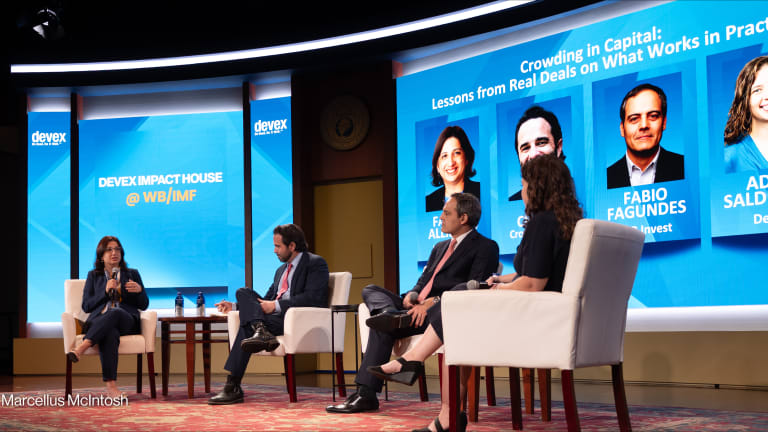
DAVOS, Switzerland — J.P. Morgan announced this week that it had created the J.P. Morgan Development Finance Institution, a first for a commercial entity.
The new department in J.P. Morgan’s Corporate &Investment Bank will focus on development-oriented financing in emerging markets, and is expected to finance more than $100 billion annually.
“We want there to be a coalescence around a standard about what represents development finance for a private sector bank like us.”
— Daniel Zelikow, global head, J.P. Morgan Public Sector Group“What we're aiming to do here is we're going to be applying a development finance lens to our existing product, structuring, financing, and distribution capabilities, in order to be more relevant in the world of development finance,” Daniel Zelikow, the global head of J.P. Morgan’s public sector group and co-head of the infrastructure finance and advisory practice, who will chair the DFI’s governing board, told Devex.
“In other words, scaling up our own participation in originating, structuring, and distributing development finance assets whilst also becoming more commercially successful in working with emerging market countries that have development challenges.”
The story behind the creation of the J.P. Morgan DFI can be traced back several years to when Zelikow helped put together the debut sovereign bond for Ethiopia. The proceeds of that bond were used to finance the construction of a dam, which was also financed by the World Bank. The World Bank’s investment was considered development finance, but J.P. Morgan’s was not.
That prompted Zelikow to consider whether the bank could apply the same standards as development banks when they classify investments as development finance, he explained. Eventually, the multinational investment bank decided there was a way to scale its investments in this area while gaining commercial advantages.
The bank then signed a memorandum of understanding with the International Finance Corporation, which helped J.P. Morgan adapt the IFC Anticipated Impact Measurement and Monitoring system to its business model.
While the DFI will be a purely commercial activity, all of its transactions in World Bank-eligible borrowing countries will be classified using the new methodology based on AIMM. The bank has published its methodology online and will be asking with every deal what the investment gap is and how a specific transaction fills that gap. Sharing that information was a deliberate choice, Zelikow said.
“It's not just because we want to be transparent about what we're doing, but we also hope and expect that other firms will follow our lead,” he said. “We want there to be a coalescence around a standard about what represents development finance for a private sector bank like us.”
More standardization of development finance from institutional investors will ultimately lead to more money flowing to development finance, Zelikow said.
J.P. Morgan will operate differently than other DFIs or development banks in that it will be an intermediary, making deals but then distributing them to other investors, rather than holding them on its own balance sheet, he said. The goal is to prove that development finance is a profitable line of business for the institution — and by doing so, grow its presence in a sustainable way and attract new capital into the sector, Zelikow said.
While J.P. Morgan estimates its DFI will do more than $100 billion in deals a year, it won’t necessarily be new investments. Most of that capital will come from deals the bank may have already been doing that will now be evaluated more intentionally, though Zelikow said he does expect it to create significant new business.
“We wouldn't be doing this in our corporate and investment bank if we didn't think we were going to grow our business,” he said.
The DFI’s investments are likely to skew toward middle-income countries rather than the poorest, but it will do deals in low-income countries as well, he said. There will be certain sectors, such as tobacco, that it won’t invest in, similar to other DFIs. But Zelikow expects that the bank will invest in a wide range of sectors, with a likely focus on certain issues such as renewables, clean power, and equal opportunity for women.
Zelikow said the financial institution has thought deeply about its role in the broader development finance ecosystem. While J.P. Morgan has worked with many DFIs and multilateral development banks financing them, it is now getting involved in the development mission, he said. J.P. Morgan expects that the creation of this DFI will lead to more activity for other DFIs and international financial institutions, Zelikow said.
“I think that what it's likely to do is result more in a segmentation of our involvement rather than competition,” Zelikow said. “We'll be in a stronger position to mobilize institutional capital to our projects and theirs, even if we're not directly collaborating on the same transaction.”
The bank will be using similar metrics, it will have more people focused on development finance generating transaction ideas, and it can focus on middle-income countries as DFIs are increasingly focused on lower-income countries, he explained.
“The world’s existing DFIs want more private finance to enter the development sphere. So this is intended to do just that,” Zelikow said.








